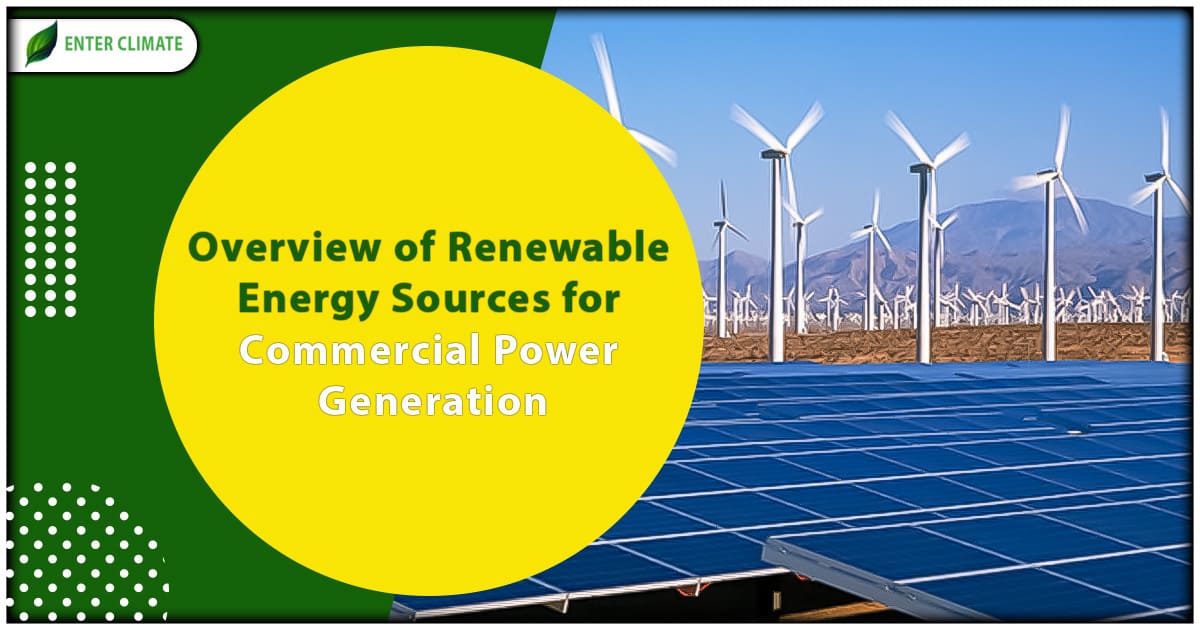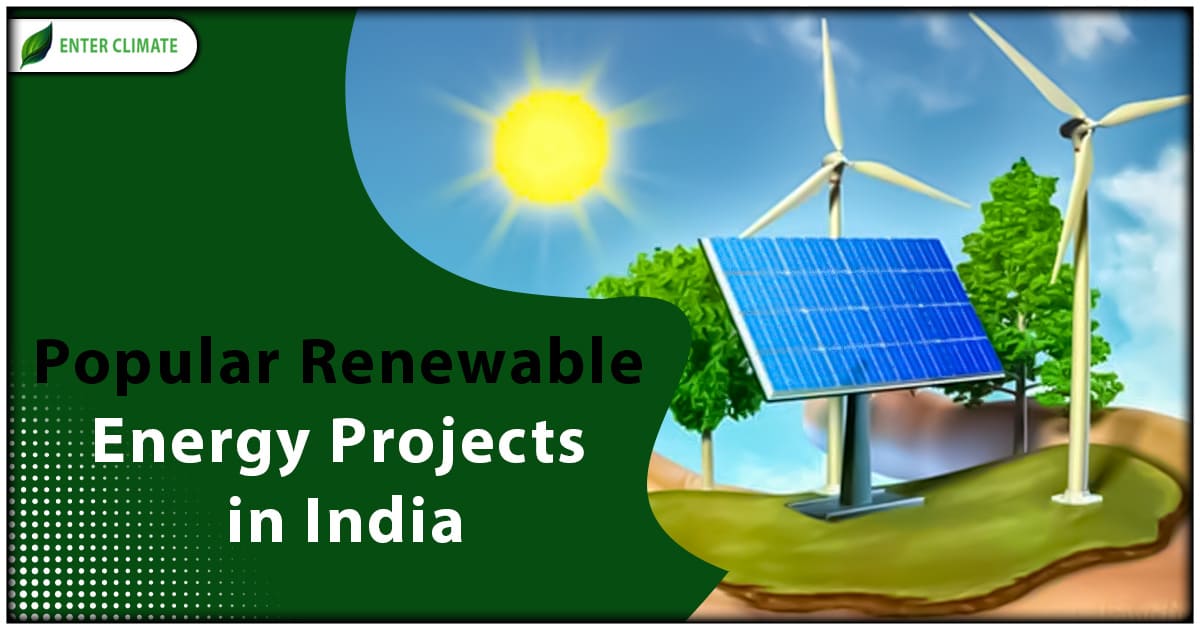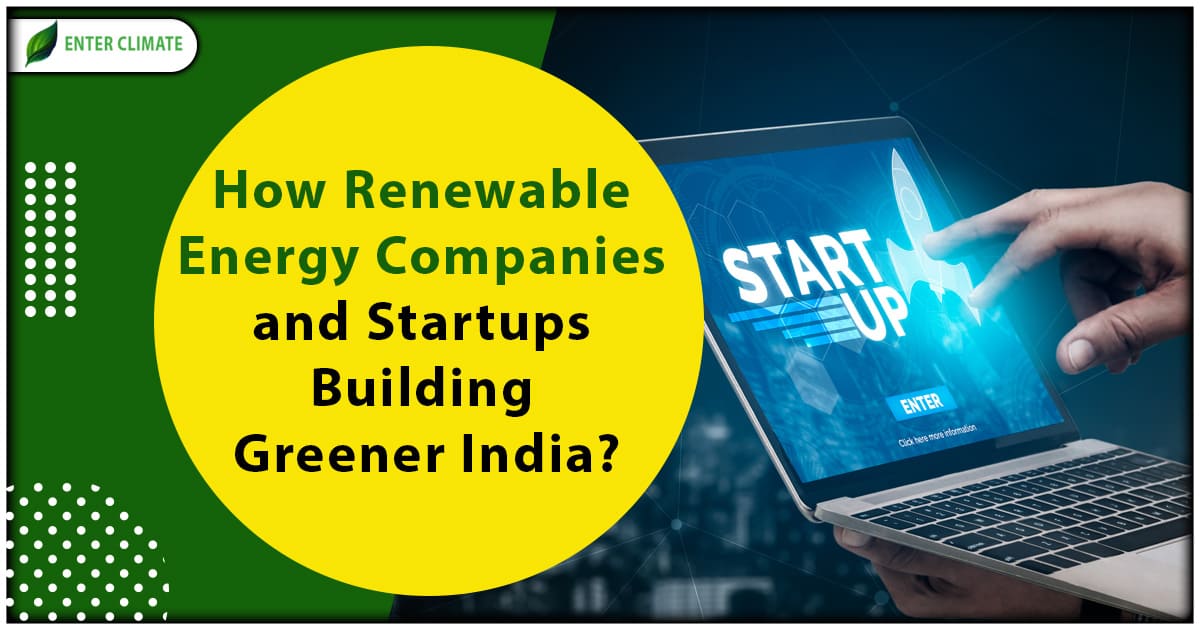Overview of Renewable Energy Sources for Commercial Power Generation
 02 Aug, 2023
02 Aug, 2023 
A renewable energy source refers to sustainable energy, something that is inexhaustible and endless. Renewable energy is obtained from natural sources that renew faster than they are consumed. Examples include sunlight and wind, which continually replenish themselves. These renewable energy sources are abundant and widely available. Whereas fossil fuels like coal, oil, and gas are non-renewable resources that take millions of years to form. When burned for energy production, fossil fuels release harmful greenhouse gases like carbon dioxide, contributing to the climate crisis. Generating renewable energy emits significantly fewer greenhouse gases than burning fossil fuels[1]. Transitioning from fossil fuels, which currently account for most emissions, to renewable energy is crucial in combating climate change. Moreover, renewable energy is now more cost-effective in most countries and generates three times as many job opportunities compared to the fossil fuel industry.
Examples of common renewable energy sources for Power Generation
Some common renewable energy sources are as follows:
- Solar energy
Solar Energy is one of the major renewable energy sources. Solar technologies offer various applications, providing heat, cooling, natural lighting, electricity, and fuels. These technologies convert sunlight into electrical energy through photovoltaic panels or mirrors that concentrate solar radiation. Sunlight is one of our planet’s most abundant and freely available energy sources. In just one hour, the solar energy that reaches Earth’s surface surpasses the total energy needed for an entire year. While it appears to be a perfect renewable energy option, the practical use of solar energy fluctuates based on factors such as time of day, season, and geographical location. Remarkably, solar energy remains the most abundant resource among all energy sources and can even be harnessed during cloudy weather. The rate at which solar energy reaches Earth is about 10,000 times greater than the rate at which humanity consumes power.
- Wind energy
Wind energy is another major renewable energy source that is generated when windmills capture the kinetic force of moving air using large wind turbines situated on land (onshore) or in bodies of water (offshore). While wind energy has been utilized for centuries, recent advancements in onshore and offshore wind energy technologies have emerged, maximizing electricity generation through taller turbines and larger rotor diameters. The average wind speeds vary significantly depending on the location, but the technical potential for wind energy worldwide surpasses the current global electricity production. Most regions across the globe possess abundant potential for significant wind energy implementation. Although many areas experience strong wind speeds, the most optimal locations for generating wind power are sometimes found in remote regions. Emphasizing offshore wind power unlocks tremendous potential for harnessing this renewable energy source.
- Geothermal energy
Geothermal energy taps into the available thermal heat from the Earth’s interior, extracting it from geothermal reservoirs through wells or other methods. These reservoirs can be categorized as hydrothermal reservoirs, naturally hot and permeable, or enhanced geothermal systems, which are made sufficiently hot through hydraulic stimulation. Once brought to the surface, fluids of different temperatures can be utilized to generate electricity. The geothermal renewable energy sources for generating electricity from hydrothermal reservoirs are well-established, dependable, and have operated for over a century.
- Hydropower
Hydropower captures the energy of water as it moves from higher to lower elevations, and it can be generated from either reservoirs or rivers. Reservoir hydropower plants utilize stored water in a reservoir, while run-of-river hydropower plants tap into the natural flow of the river. Hydropower is among the largest renewable energy sources in the electricity sector. Hydropower reservoirs serve multiple purposes, serving as a water source for drinking, irrigation, flood and drought control, navigation, and energy supply.
- Tidal energy
This represents another variation of hydro energy that harnesses the power of the tidal currents to operate turbine generators. While tidal flow is not constant, unlike other hydro energy sources, its predictability is remarkably high, allowing it to effectively offset the periods of low tide current.
- Bioenergy
This refers to the process of converting plant-based solid fuels into electricity. While biomass entails burning organic materials to generate electricity, the contemporary approach is considerably cleaner and more energy-efficient. By transforming agricultural, industrial, and domestic waste into solid, liquid, and gas fuel, biomass facilitates power generation at a reduced economic and environmental expense. In rural areas, biomass is primarily utilized for cooking, lighting, and space heating, especially among lower-income populations in developing nations. Modern biomass systems incorporate dedicated crops or trees, agricultural and forestry residues, and various organic waste streams. The energy produced from burning biomass does produce greenhouse gas emissions, albeit at lower levels compared to burning fossil fuels like coal, oil, or gas. Nonetheless, bioenergy applications should be restrained due to potential negative environmental consequences associated with the large-scale expansion of forest and bioenergy plantations, which may lead to deforestation and land-use changes.
Business ideas on Renewable Energy Sources
Some very popular business ideas based on renewable energy sources are as follows:
- Solar Panel Installation
Concerning non-renewable energy options, solar energy stands out as one of the most profitable business opportunities. As a solar panel installer or fabricator, you will be responsible for placing Photovoltaic (PV) panels on homeowners’ rooftops. To operate your business, you can hire installers and fabricators as contractors. Alternatively, you could venture into solar sales and distribution, importing wholesale solar panels from China to supply to installers and retailers. You can offer various solar products like solar PV, thermal systems, solar attic fans, solar cooling systems, etc. Obtaining a distributorship license is the ideal way to kickstart this enterprise.
- Wind Mill installation, maintenance, and servicing business
Following solar energy, wind energy ranks second most popular renewable energy source. Engaging in the wind turbine installation business involves employing workers to provide, set up, install, and maintain large wind turbines responsible for electricity generation. There is significant demand for wind turbine fabrication, installation, and maintenance services from wind energy generation companies. Alternatively, you can venture into becoming a wind farm developer. A wind farm consists of vast wind turbines in high-wind regions. As a wind farm developer, you would assemble these turbines from the ground up. However, starting this business involves navigating through various bureaucratic hurdles.
- Geothermal Power Installation
Geothermal power harnesses the energy from the Earth’s heat sources, making them a valuable energy resource. This energy source can be derived from deep underground reservoirs of hot water or steam. Numerous potential sites exist for establishing geothermal power plants. Geothermal energy can be utilized for electricity generation both on and off the grid, making it beneficial for rural electrification. Nevertheless, starting a geothermal business can be pretty expensive.
- Biofuel and Bio Diesel Production
As fossil fuels are depleting rapidly, energy companies are actively seeking alternatives. Among the most promising green alternatives to fossil fuels is biofuel. Setting up a small-scale biofuel or biodiesel production unit can be highly advantageous, especially in areas with abundant key raw materials like vegetable oils. The demand for biofuel extends to the automobile industry and the aviation sector, where it is used to power jet engines. Many consider biofuel to be the future of the energy sector.
- Electric Vehicle Distribution and Selling
Electric vehicles, also known as EVs, are experiencing increasing popularity worldwide. The rapid rise in oil prices, driven by geopolitical situations and conflicts, is compelling people to switch to EVs. To attract customers, automobile companies are introducing new EV models annually. In this favourable context, opening an EV distribution or retail selling store presents a promising business opportunity, as there will be no shortage of potential customers. Alternatively, for those with greater ambitions, starting an E Rickshaw manufacturing plant can be a viable venture.
- Rainwater Harvesting
Rainwater harvesting enterprises offer a means for companies and communities to diminish their reliance on fossil fuels. These businesses can opt for rainwater as an alternative to their primary water source through rainwater harvesting. The conventional water supply, which necessitates considerable fossil fuel for processing and distribution, lacks eco-friendliness. In contrast, rainwater harvesting allows for direct collection from rainwater tanks. By setting up the necessary infrastructure, such as catchment areas and pipes, these businesses facilitate the redirection of rainwater to the storage tank.
- Home Energy Consultancy
As a consultant in home energy consultancy, your role will be to assist homeowners in reducing their energy consumption. You will educate your clients about various renewable energy sources, such as solar, wind, and water, among others. Starting this consultancy business doesn’t require a significant upfront investment, but a wealth of experience in the energy sector is essential. Your services can be offered to clients in both the private and public sectors.These renewable energy business ideas hold great profit potential. The demand for such businesses is projected to surge in the upcoming years due to countries worldwide committing to reducing their carbon emissions. In achieving this goal, they will seek assistance from renewable energy businesses like yours.
- Co-generation power plant based on bagasse
The current situation calls for the immediate establishment of a co-generation plant that utilizes bagasse for power generation. Given the growing power generation requirements, the demand for such a plant is significantly rising. Bagasse, a waste product from the sugar industry, holds a critical role in meeting this need.
- Hydro-based power plant
Hydropower, a sustainable energy source, harnesses the Earth’s water cycle to generate electricity. It utilizes the kinetic energy generated by the movement of water flow downstream in lakes and rivers, converting it into electrical energy. The utilization of running water’s energy for electricity generation has been in practice for many decades.
- Bagasse-based co-generation power plant
India’s energy demand is experiencing rapid growth due to the swift industrialization and urbanization in the country. In a developing economy like India, the energy demand typically outpaces supply, leading to an increase in the cost of energy and, subsequently, higher power tariffs for consumers.
- Biogas power plant from cow dung
Biogas plants can process a diverse range of organic residues as their main fuel input. This comprises materials such as cow dung, agricultural residue, effluent discharge, food residue, and more. Many agricultural and food production processes yield substantial quantities of organic residues as by-products.
- Biogas production
A successful biogas program enables the efficient utilization of cow dung for gas recovery while also partially supplementing the nutrient requirements of plants. Implementing a biogas program contributes to enhancing rural living, including rural sanitation. Biogas fermentation, a process commonly occurring in nature, can be described as a biological process.
- Power plant based on Biomass gasification
A bio-gas power plant is a non-conventional energy source that utilizes solid carbonaceous biomass fuels from living plants and animals. Given the abundance of waste materials in our country, producer gas can be readily converted into energy. This energy source can generate electricity, making it feasible to supply power to nearby and remote areas.
- Biomass power generation plant
Biomass refers to biological material originating from living or recently living organisms. In the context of biomass for energy, it commonly refers to plant-based materials, although it can encompass both animal and vegetable-derived substances. Biomass primarily comprises plant matter utilized for electricity generation or heat production, often achieved through direct incineration.
Documents required for setting up a business based on Renewable Energy Sources
Different types of renewable energy businesses may have specific documentation needs, but some standard documents are commonly required across the board. These documents are essential for ensuring compliance with legal norms and for establishing a legitimate and reliable business operation.
- Company Incorporation documents: These documents establish the legal identity of the business entity and include the Certificate of Incorporation and the Company Registration Certificate.
- Articles of Association and Memorandum of Association: These are important legal documents that outline the company’s internal rules, regulations, and objectives.
- GST Registration: Businesses must register under the Goods and Services Tax (GST) system, which enables them to collect and remit taxes.
- Trademark Registration: Protecting the business’s brand identity through trademark registration helps prevent unauthorized use by others.
- MSME Registration: Micro, Small, and Medium Enterprises (MSME) registration can provide certain benefits and incentives to businesses in the renewable energy sector.
- Shop and Establishment license: This license is necessary for businesses to operate legally and is usually issued by the local government authority.
- Pollution NOC: To ensure compliance with environmental regulations, a Pollution NOC certifies that the business activities will not cause significant environmental harm.
- Permanent Account Number (PAN): PAN is a unique ten-digit alphanumeric identifier issued by the Income Tax Department, essential for financial transactions.
- Tax Deduction and Collection Account Number (TAN): TAN is required for businesses to deduct and remit taxes on certain payments.
- Bank Account details: Business bank account details are essential for financial transactions and receiving payments.
- Loan Documents: If the business requires financing through loans, the necessary loan documents need to be prepared and submitted.
- CEIG Approval(Chief electrical inspector to the Government of state): In the renewable energy sector, CEIG approval is necessary to ensure the safe and proper installation and operation of electrical systems.
Conclusion
Renewable energy resources stand as a promising and sustainable solution to meet the world’s growing energy demands while mitigating the impacts of climate change. Solar, wind, hydropower, geothermal, and biomass offer abundant, clean, and inexhaustible energy sources. Embracing these resources holds the potential to reduce greenhouse gas emissions, enhance energy security, and foster economic development. The transition towards a renewable energy future requires continued innovation, investment, and global cooperation to unlock the full potential of these resources and create a cleaner, greener, and more sustainable world for future generations. It is recommended to seek expert guidance to ensure the documents that would be necessary based on the type of business based on renewable energy sources.
FAQs
The three main obstacles to renewable energy sources are inadequate infrastructure, the limited presence of financial intermediaries, and a lack of investor comprehension.
Some interesting facts about renewable energy are – Solar energy has been in use for nearly two centuries. Renewable energy generates more job opportunities for women than non-renewable energy.
Renewable energy sources predominantly produce energy during specific periods of the day, which may not align with peak demand hours. The intermittent nature of sunshine and wind makes it challenging to maintain a consistent power supply 24/7.
Currently, hydropower holds the leading position as the most substantial renewable energy source in the electricity sector.
Solar energy holds a substantial portion of India’s renewable energy mix, and advancements in solar technology, such as rooftop solar installations and floating photovoltaics, are increasingly becoming prominent.
Solar energy is regarded as the dominant force among renewable energy sources.
In 2022, China, the U.S., and Brazil emerged as the top countries for installed renewable energy capacity. China took the lead with an impressive capacity of approximately 1,161 gigawatts.
As of February 2023, renewable energy constituted a mere 12.3% of India’s total energy. Excluding large hydro and nuclear plants, India’s renewable energy capacity reached 122 gigawatts, according to the latest monthly report from the Central Electricity Authority (CEA).
In 2022, China, the U.S., and Brazil emerged as the top countries for installed renewable energy capacity. China took the lead with an impressive capacity of around 1,161 gigawatts, while the U.S. followed closely behind in second place with a capacity of approximately 352 gigawatts.
Iceland fulfils its entire electricity demand from renewable energy sources. The island’s volcanic activity provides a substantial geothermal energy source, contributing to around one-quarter of the country’s electricity supply.
Read our Article: Popular Renewable Energy Projects In India
Categories
Latest Post
Air pollution Dispersion Modeling
Natural Disaster Risk Assessment
Endangered Species Protection
Aquifer Recharge Project
Sustainable Sanitation Solutions














